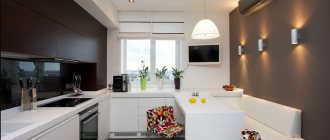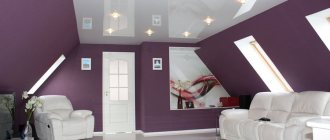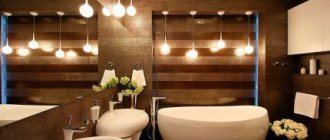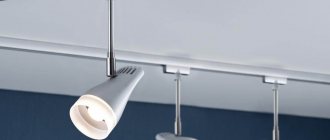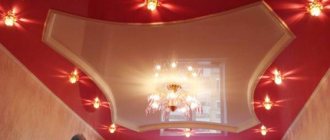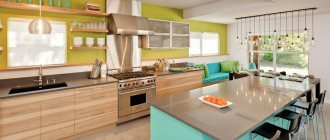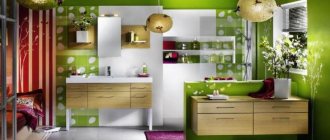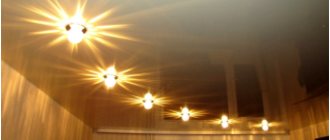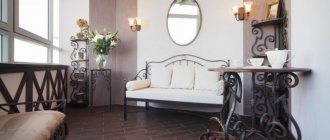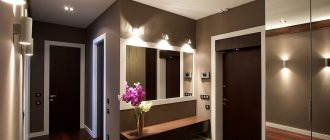Device features and benefits of use
Spotlights got their name due to the small size of the lamp and the external effect of radiation from a single point. The lamp is enclosed in a shade; hence the main feature of the spots: the light dispersion angle does not exceed 30°, and the light flux itself has the shape of a cone.
A small angle allows you to illuminate a limited part of the space, so for uniform lighting, use a group of spots with a fairly dense arrangement.
The steady demand for spot lighting is explained by the following benefits of use:
- Spots are practically invisible and therefore adapt to any interior. Small ceiling lamps are hidden under the surface when installed and therefore do not burden the space.
- You can choose spots for any style. Some models allow you to adjust the direction of the light, which increases their design capabilities.
- You can evenly illuminate any room. A chandelier does not always cope with this task, but well-placed spots on the ceiling will easily solve the problem.
- You can organize partial lighting of the room, and thereby significantly save electricity.
Types of spotlights
If we talk about appearance, then, in addition to round ones, there are models of square, oval and non-standard shapes. It is convenient to classify spotlights according to the place of attachment:
- Built-in. Such lighting fixtures decorate suspended and suspended ceilings, walls and stairs. They require lamps with a minimum heating level so as not to damage the base.
- Invoices (external). There are wall and ceiling; the structure is fixed with screws, the light flow is distributed by the diffuser of the outer housing.
- Furniture. Mortise and overlay spot models help illuminate furniture fronts, work surfaces, as well as the interior space of shelves and drawers.
- Hanging. Such spotlights take up more space in the interior, since installation is carried out on special mounts, and the device remains visible. Many hanging models are equipped with a rotating mechanism.
Built-in ceiling models, in turn, differ in the type of installation:
- Models for installation in rigid suspended structures (plasterboard, plastic panels, slatted ceilings); equipped with two fastening clips.
- Models for suspended ceilings. In this case, installation is carried out using special brackets before the canvas is tensioned.
Choosing spotlights
Despite all the advantages of spotlights, it is still worth noting that as individual lighting they can only be used in rooms with a small area. In rooms with a large area, spotlights alone will not be enough.
The solution to this problem is simple - just make a combined lighting, which will include both a chandelier and spotlights. This option provides enormous space for design solutions and is widely used when zoning a room.
When choosing spotlights for a particular room, you should pay attention not only to its area. The height of the walls must also be taken into account.
Here are a few more points that you should definitely take into account when choosing spotlights for your room:
The stretch ceiling canvas begins to change its shape (deform) at temperatures above 60 degrees (this is a fabric canvas, film - even at 40 degrees). Therefore, the power of lighting devices should not exceed these indicators.
The recommended number of spotlights is 1 point per 2 square meters of area.
When choosing a spotlight, it is better to give preference to models equipped with a fairly wide side - it will allow you to hide the ring designed to prevent wrinkles and tears.
If you need to regulate the direction of the angle of incidence of light, it is better to give preference to special moving models. When choosing a spotlight, you should also take into account what kind of fabric will be used to decorate the ceiling.
A glossy film can reflect light rays, so a polyhedron-shaped lampshade would be an ideal option for it. But the matte canvas looks great with lamps whose light is directed clearly downwards.
How many spots are needed and how to place them
To determine the optimal number of spotlights (if you mean main lighting), there is a special formula, but the calculation can be done in a simpler way. To do this, the following calculations are carried out:
- The total number of watts per room is determined. The area of the room is multiplied by the number of Watts required by lighting standards per 1 m2. According to SNIP, the lighting level for a bedroom is 12 W/m2, for a nursery - 15 W/m2, for a living room - 20 W/m2.
- To determine the minimum number of lamps, the total number of Watts is divided by the power of the selected lamp.
Inverse problem: to determine the power of one lamp, the total number of Watts is divided by the number of lamps.
Spotlights are installed taking into account the following conditions:
- The distance to the wall must be at least 70 cm.
- To determine the distance between lamps, the length of the wall is divided by the number of spots.
- To determine the distance of the lamps from the wall, half the length of the wall is divided by 2.
Advantages and disadvantages
Positive and negative qualities of products that will help you understand whether this lighting method is beneficial.
Advantages
- Due to their compactness, they fit perfectly into the design of any room in an apartment or house.
- Can be used both as main and additional lighting.
- They allow you to achieve zoning of space and provide light to individual areas.
- By using spotlights with LEDs or halogen bulbs, energy costs are reduced.
- This type of lighting is characterized by an unlimited choice of installation locations. The products can decorate any area, niche, arch, etc.
Due to models with spectacular decor, it is possible to advantageously emphasize the style of the interior.
Lamps with warm or cool shades can create a comfortable atmosphere in the room and give the design a certain mood, depending on individual preferences.
Flaws
- Surface-mounted and recessed lighting fixtures have some installation difficulties and require a professionally designed installation diagram.
- For products with 12 Volt light bulbs, the purchase of a special step-down transformer is required.
- Some types of light sources require a ceiling with a special design.
Ceiling options
The placement of spotlights needs to be thought out in advance, especially if a suspended ceiling is to be installed.
The backlight can be located either symmetrically or in a chaotic manner.
Light sources built into a multi-level suspended or suspended ceiling will allow you to create a unique interior, highlight the architecture and atmosphere of the room.
The lighting will be uniform and of the highest quality if the devices are installed so that the rays of the light flux intersect above all elements in the room.
The best option is built-in spotlights along the perimeter of the ceiling plane. They can be switched on together with a central chandelier to create more intense lighting.
The parallel arrangement of lamps in several rows will help to achieve proper comfort in the room.
A cross-shaped arrangement of light sources will fit perfectly into a small room with a low ceiling. The corner space is equipped with single models, and a gimbal structure is installed in the center.
Also, for a small room, the arrangement of lamps in the form of a square is appropriate.
In order to illuminate a certain area, an arc-shaped arrangement of lighting fixtures is used. Thanks to this technique, it is possible to soften the strict interior.
Some rooms require the installation of light sources in a checkerboard pattern. For example, a similar solution is often found in the design of an island-type kitchen, where good lighting of all zones is required.
Wealth of choice: types of devices
Lighting is a magical “tool” in the hands of a designer. With the help of properly selected devices, you can make the room radiant and solemn or create an intimate atmosphere in the room. Today, built-in lamps are becoming more and more in demand on the market. When installed, their body is immersed in special niches in a suspended or suspended ceiling. The popularity of the products is due to their versatility.
Recessed lamps in the interior can be used as general lighting, to illuminate local areas of the room, or to highlight individual zones or objects.
These devices can have different designs, shapes and colors, which allows you to realize the most daring design ideas. When purchasing, you should decide what type of lamps you need:
- Stationary. Models like Arte Lamp Fine A2409PL-1WH provide a constant, unidirectional flow of light.
- Rotary. At the heart of the device there is a special mechanism that allows you to rotate the lamp. In this way, the direction of the outgoing rays can be adjusted.
Ceiling built-in devices are almost completely hidden in the ceiling, so they fit perfectly into any room and save space. The lamps are not only practical, but also economical. When properly connected to the network, they make it possible to partially illuminate the room where it is needed. Let's try to figure out how to successfully use lighting technology in rooms for different purposes.
Back to Contents
Photos in the interior of the rooms
Features of installing lamps in the interior of specific premises.
Spotlights in the kitchen
The kitchen space requires a lot of light. It is advisable to install several devices with a bright and soft light flux. In this way, you will learn how to create enough lighting in the kitchen and at the same time achieve a pleasant environment.
If there is not enough free space, you can equip the kitchen wall cabinets with lighting.
Spot lighting in the kitchen in combination with an LED strip of different colors will add even more originality to the design.
Spotlights in the living room interior
In the interior of a living room with a ceiling chandelier, it is better to install light sources with low power. Thus, when the chandelier is turned off, a pleasant, soft and muted glow will emanate from the lamps
. In this case, point devices can be placed only on one side of the ceiling.
For a hall without a central chandelier, almost any arrangement of light sources is suitable, for example, in the form of a circle, square, oval or even a diamond.
Examples in the interior of the corridor
Typically, the design of a hallway assumes the most simple arrangement of lighting fixtures. For a narrow corridor, one row of 3 or 5 point lamps is suitable. In a square room, it is appropriate to install two rows consisting of 3 or 4 light bulbs.
Spot lighting in the bedroom
Perimeter lighting will look great here. A good solution is to install a multi-level stretch ceiling, decorated with dim lighting.
LED strip mounted on the sides of the ceiling plane will complement spotlights advantageously.
Thanks to light sources, the bedroom can additionally be divided into an area with a bed, dressing table or wardrobe.
Lamps and purpose of rooms
The parameters of the lamps - their future location, power, design - are designed for a specific room.
How the room is used will influence the choice of fixtures as follows: Living room. In the living room, more than anywhere else, an adequate level of lighting is important.
Therefore, regardless of the design of the accessory, they pay attention to the quality of the lighting equipment and the technical parameters of the lamps (especially power). Do not forget about the diameter and height of the chandelier: they must correspond to the dimensions of the living room
In the recreation areaSource prorab.vebfabrika.ru
Bedroom
It is important to create an atmosphere conducive to complete relaxation. Therefore, a chandelier for a bedroom with a suspended ceiling should become a source of soft, diffused light
To complicate the lighting design, both classic and modern chandeliers are often complemented by spotlights, which look very stylish.
In an elegant bedroomSource hzcdn.com
Kitchen
In the kitchen, both excess and lack of light are bad, so it is important to choose a chandelier that is comparable to the size of the room. The design of the main chandelier supports the style of the room; spotlights highlight the work area, LED strip will create the right mood
Chandelier and track lightsSource i.pinimg.com
About the “starry sky” stretch ceiling in the following video:
Light sources in spotlights
Various types of lamps can be installed in these lighting devices. Manufacturers' products include incandescent, halogen and fluorescent light sources. All of these devices have certain pros and cons. But the best option is LED ceiling spotlights.
They have several obvious advantages that set them apart from other light sources.
LEDs:
- have maximum light output;
- use electrical energy economically;
- create uniform light;
- have the longest service life.
These devices have another important advantage. The LED recessed ceiling lamp can be installed in tension systems without fear for the integrity of the canvas.
During operation, these light sources practically do not emit heat and do not have a negative impact on the structure of the polyvinyl chloride coating.
Selection of light bulbs
It is important not only to choose the right design, but also to choose the best quality lamp for them. For these purposes, halogen, LED, and mercury energy-saving lamps are used. Conventional incandescent mirror lamps are often recommended.
When making a decision, not the last parameter is the degree of heating. After all, elevated temperatures often lead to heating of the finishing material and its deformation. In this case, the protective gasket partially solves the problem, since heated air can accumulate behind the ceiling space.
Halogen lamps overheat quite strongly and are not very economical. They are used to create a powerful luminous flux or to illuminate the interior.
LED lamps are considered an excellent option. They are safe, have a long service life, and the use of a dimmer allows you to adjust the lighting. Mercury lamps are economical, but the light parameters are not very pleasing to the eye.
Determining optimal power
Determining the required power depends on several factors:
- purpose of the system;
- room area;
- ceiling height;
- lamp parameters.
The use of recessed or overhead spotlights for ceilings as the main lighting requires calculations according to general rules. On average, a 35W light source is installed per 2m2 of area. If this is additional lighting, the indicators of the ceiling chandelier are subtracted from the total power.
When creating comfort in a certain area, the fundamental calculation criterion is its area.
The number of light sources required depends on the type and power of the lamps. Halogen, traditional, LED recessed spotlights have different parameters.
Many models are designed to accommodate any type of lamp.
Types of spotlights for the ceiling
Spotlights are such lighting devices, with the help of which it is very easy to solve the problem of arranging both general and local lighting of any room. The modern lighting market offers consumers a huge selection of similar products of various shapes, colors and sizes. Spotlights
They have many areas of application and are used under various conditions.
All modern spotlights can be divided according to the method by which they are installed into the following types:
1. Overhead spotlights . Such lighting devices are installed in cases where the ceiling of the room is a continuous solid base, for example, made of concrete. Overhead spotlights are very convenient if it is not possible to make a special niche for their installation.
Installation of these lamps is carried out even when it was provided for by the development of the design of the surrounding interior of a given room. Its appearance, thanks to the installation of overhead spotlights, acquires additional attractiveness. The design of such lamps consists of a mounting platform and a housing on which a light flux diffuser of various configurations is installed.
2. Recessed spotlights . This type of spotlights is the most common. Installation of spotlights is carried out on any surface that is hollow inside. The vast majority of such lamps are mounted on a plasterboard ceiling or its suspended equivalent. These lighting devices are very often installed in furniture, for example, wardrobes.
In addition to the ceiling option for installing recessed spotlights, they are also mounted in the floor and walls of the room. This is very common when organizing lighting for stairs and swimming pools.
The configuration of recessed spotlights can be completely different. Such a device can be individually selected for any installation location. Structurally, this lamp is a solid body, which contains elements for fastening it and a fixing mechanism for installing lamps. The simplicity of the design of recessed spotlights is their main advantage over other lighting devices.
This spotlight can be installed in such a way that it will be completely invisible on the surface of the ceiling plane, and, if desired, it will be one of the central elements of the overall interior of the room.
3. Hanging spotlights . This type of spotlight differs from its built-in and surface-mounted counterparts in that its body is mounted at a certain distance from the ceiling surface. It is usually suspended from a power cable made in a decorative shape. The cable connects the base of the lighting device to its housing, which contains the light bulb.
In order to install pendant spotlights
It is enough to use any ceiling base. It can be solid, tensioned or suspended, made of plasterboard. Such spotlights are very well suited for use when organizing decorative lighting for a room.
Modern spotlights are also divided according to the type of electric lamps used for lighting. They are divided into:
— LED spotlights;
— lamps with incandescent lamps;
— halogen spotlights.
What is typical, but in almost each of the spotlights you can install lighting lamps of any type. This is due to the fact that the bases of different lamps have standard sizes and configurations.
For spotlights
those that use incandescent lamps require greater depth for their installation. This is due to their size. Halogen lamps get quite hot. But the use of LED lamps does not have these disadvantages.
Spotlights
They also have a rotating or non-rotating design, which makes it possible to change the direction of its illumination.
Spotlights
are presented for sale with a very wide range of their models, which have a very affordable price. This is what makes such lamps very popular among consumers.
Manufacturers of electrical equipmentClick on the manufacturer's logo to view all of its products in this section. Also in the section “Spot recessed luminaires for ceilings and furniture”: Recessed spotlights MR11, for base G4/G5.3/GU5.3 » Recessed spotlights for lamp MR16, for base G5.3/GU5.3 » Recessed decorative lamps MR16 with LED lighting for base G5.3/GU5.3 » Recessed decorative luminaires MR16, for base G5.3/GU5.3 » Recessed spotlights for socket GX53 and GX70 »
| site map | | |||||||||||
| © VDL Company LLC, 2007-2020 Privacy Policy | ||||||||||||
| Legal information | ||||||||||||
| Webis Group |
| +7 |
Lamp arrangement
All spotlights have a similar design, including:
- mounting base;
- housing with diffuser;
- Light source;
- connecting cable.
The model range of these lighting products includes various modifications with more complex designs and additional devices. Built-in and overhead ceiling spotlights can be adjusted by remote devices. There are models with an extended lighting angle, equipped with dimming that corrects the illumination.
Lamps differ in the level of protection from dust and moisture, which determines the scope of their intended use.
The optimal lighting fixture for suspended ceilings
Which lamps are suitable for suspended ceilings directly depends on the purpose of the room.
In the bathroom or kitchen, lamps with a high level of protection from moisture and high temperatures must be installed. It is also undesirable to use lamps with many beautiful decorative elements in the bathroom. In a children's room, devices must be shock-resistant and reliable. The choice of device for installation in the living room and hall is greater - it all depends on the taste of the owners and the design of the space. The bedroom does not need bright lighting, so here you can get by with several sources without a central chandelier. The corridor is usually devoid of natural light; several powerful lamps can be used as lighting instead of a chandelier. In industrial and office premises, the main thing in a lamp is reliability, functionality and security. The appearance of the device is not as important here as its technical characteristics.
When choosing lamps, it is important not to forget about saving electricity. The optimal light bulb for an apartment with a suspended ceiling will be an LED one - although it is more expensive than other sources, its price is justified by its long service life and low energy consumption
Installation of spotlights
The question of how to install a spotlight is of interest to many craftsmen who are doing this for the first time. There is nothing complicated in this work.
The main thing is to decide on the installation method and carry out all the work as carefully and accurately as possible.
It is worth noting that, depending on the installation method, a distinction is made between recessed and surface-mounted lamps.
Let's take a closer look at both types:
- Built-in. When installing such spotlights, a hole is made in the canvas. The lamp is installed in such a way that part of its body protrudes outward, that is, it turns out to be built into the ceiling surface.
Such lamps are used on frameless bases, such as a brick wall or a concrete ceiling.
- Surface- mounted spotlights are used exclusively for suspended ceilings. Their level is always below the ceiling level.
When choosing spotlights, you must take into account the method of mounting them - this will allow you to avoid annoying mistakes. Installation of overhead lamps requires the presence of a frame.
In turn, recessed lamps can be divided into two groups depending on their purpose. They can be for suspended or suspended ceilings.
The configuration of spotlights directly depends on their type. Thus, the standard design of a surface-mounted luminaire consists of a special housing equipped with a diffuser and a fastening part.
A recessed lamp consists of fasteners and clamps for lamps built into a special housing.
Installation of such lamps is extremely simple; even a beginner can cope with this task.
What is a spotlight
Built-in lamps, one of the few light sources, are capable of creating light spots directed in the desired direction. Thanks to this function, they got their name. They can be installed in completely different rooms, because thanks to their laconic, discreet design and small size, the spots will look good in any room and will not disrupt the overall concept of the interior. Directing the light beam onto individual objects will allow you to unusually emphasize the design of the room and create an example of modern style from any room.
Based on design features, LED spots can be divided into the following groups:
- built-in lamps (mortise, mounted in special niches);
- overhead spot spots (attached with brackets or attached to the surface with bolts);
- combined (several light bulbs fastened together).
Small lamps can be mounted on any type of suspended ceiling. The installation method practically does not change depending on the type of material with which the surface is sheathed. On a suspended ceiling, the installation of devices is carried out by specialists, since there are some nuances when installing a structure in such material
It is important to take into account that the angle of illumination incident from the lamp is 30 degrees, so the spots are positioned so that the rays intersect. Do not place point spots closer than 60 cm from the wall and more than 1 m from each other
In order to correctly connect spotlights, you need to pay attention to some important points:
- the design of the lighting device must have a reflective layer;
- the power of the lamp must correspond to the material from which the ceiling is mounted ( if the material overheats, it may become deformed and the risk of fire increases
); - when choosing a wire, you should take into account the type of suspended ceiling (for plasterboard, a two- or three-core wire is suitable, and for less fire-resistant materials you should choose a fireproof option);
- for connections you can use special terminal blocks or tinned copper sleeves (a more reliable option);
- The connection points should be carefully protected using electrical tape or heat-shrink tubing).
On a suspended ceiling
PVC film, with its high sensitivity to heat and tendency to damage, is one of the most popular options for ceiling finishing. Therefore, if you decide to buy lamps for suspended ceilings, you need to take into account the characteristics of the material. The design of the device must provide additional thermal insulation. The permissible power of incandescent lamps is up to 60 W, halogen lamps – up to 36 W, but fluorescent and LED lamps are ideal for installation, because they have a minimum heating temperature.
Spot light, depending on the room, can perform different functions, due to which it is in great demand in the lighting market, especially when installed in a suspended ceiling. Installation of slots in a PVC film ceiling should be carried out in several stages:
- laying wiring along the ceiling (in a corrugated tube) and to the switch (single or double);
- installation of fasteners for installation (the distance between the ceiling surfaces should be at least 6 cm);
- when using 12 W lamps, it is necessary to use step-down transformers;
- installation of metal hangers for mounting the lamp allows you to adjust the height of the device if necessary;
- When installing a stretch ceiling, special rings are glued at the points where the spots connect with the wiring (to mark the area where the wires are located), and then they are cut through.
On a plasterboard ceiling
Spot lighting on a plasterboard ceiling is an excellent addition to the interior of the room. Mounting lighting slots in such material is very simple and the whole process takes very little time. Experts recommend using LED spotlights because they have a long service life, high-quality light flow and efficiency. Depending on the shape of the lamp, square or round grooves are cut into the plasterboard. You should strictly follow the markings made earlier, otherwise you may end up in a metal profile.
Adjustment type
All of the above types of spotlights can also differ in the type of adjustment. Depending on this, spotlights are:
- non-rotating – illuminate part of the room, but the direction of the light flow cannot be adjusted;
- rotating - allow you to adjust the angle of incidence of light and its direction;
- rotating and retractable spotlights are used to change lighting zones.
In terms of functional features, spotlights can also vary significantly.
Modern models are equipped with remote control, have a wider angle of light incidence, protection against dust and moisture, and other functions.
Lamps for spotlights
The characteristics of spot lighting indicate that absolutely any lamps are suitable for them - incandescent, halogen, LED.
The choice of lamp type does not in any way depend on what type of lamps is selected.
Let's look at which lamps are better:
- LED lamps have a long service life - up to 5 years. They are economical in terms of electrical consumption, and their light is pleasing to the eye.
- Halogen lamps do not heat up, which is very important for suspended ceilings (especially film ones). The light from them is quite bright, but does not irritate the eyes. The service life of such lamps is decent - up to 4 thousand hours.
- Incandescent lamps have a lower cost compared to halogen and LED lamps. And this, perhaps, is perhaps their only advantage. Incandescent lamps get very hot, so they are rarely used for lamps such as spotlights.
Looking at photos of spotlights in various interiors, we can conclude that with proper and thoughtful placement, this type of lighting is an ideal option for almost any room.
Thanks to them, not only good, proper lighting is obtained, but also a stylish interior design.
In addition, spotlights are universal, because they will fit perfectly into any style, and the soft light will make the room warm and cozy.
Advantages of recessed luminaires
In modern apartments, built-in photo lamps are an integral component, which have many advantages over conventional lighting devices. And, despite the fact that everyone is accustomed to the fact that ceiling chandeliers and table lamps are required in an apartment, you can increasingly see interiors in which these attributes are absent.
Here are just some of the striking advantages of recessed luminaires:
- Firstly, savings. At first glance, it may seem that their purchase and installation is a rather expensive undertaking. In fact, all this pays for itself quite quickly, because square recessed ceiling lamps have very low energy consumption. This is achieved due to the fact that the light source in them is a diode. Therefore, the service life of such lamps reaches 4000 hours.
- Secondly, the direction of light. This feature is useful if there is a need to highlight an object worthy of attention in the interior with light. In addition, many models have a rotating mechanism, thanks to which you can independently adjust the direction of the light flow.
- Thirdly, small sizes. This characteristic is especially relevant when it comes to standard apartments, where, unfortunately, it is impossible to install crystal ceiling chandeliers. Bulky lighting fixtures will visually narrow the space. Recessed ceiling lamps live up to their name - tiny devices, which are often hidden in the fabric of suspended ceilings, are not at all noticeable, do not “eat up” space, but brightly illuminate the room.
- Fourthly, No matter what kind of interior design you have planned, you will certainly need recessed lights for the bathroom. In modern lighting stores you can find and buy lamps of a wide variety of styles. They fit perfectly into any interior, be it ascetic high-tech or luxurious baroque.
- Fifthly, Thanks to the aluminum body, which is present in most models, they can be installed in rooms with high humidity - that is, recessed lights for the bathroom, bathhouse and sauna. And don't worry about safety at all.
How to calculate the number of lamps
Before choosing a suitable arrangement of lamps, you need to calculate the required number. It should be calculated based on the standards. These standards vary significantly for different premises.
In non-residential premises, the light should not be as bright as in residential rooms. Current standards can be found in the relevant SNiPs.
The number of ceiling lighting fixtures is calculated as follows:
- You need to multiply the area of the room by the light standard according to the standard from the table above. The result will be the total lighting power (example: 16 m? * 150 = 2400 Lux).
- Next, determine the power of the lighting sources and their types. You should know their luminous flux (let's say this value is 200).
- Then the total power must be divided by the power of one lamp. This way you can calculate the number of lamps (2400:200Lx=12 pcs).
It happens that the standards specified in SNiPs imply too bright light. But sometimes you really want softer lighting. This must be taken into account when choosing methods for lighting the ceiling with spotlights.
It's better to do everything so that you can have different options. For this purpose, lighting devices are divided into groups.
If there are two groups, then they are connected through one to the line, and then connected to a switch with two keys. The first row of lamps on the ceiling can be the main one, the second - secondary. Then you can turn on the light bulbs one at a time, and as a result the glow will be either dim or very bright.
If necessary, the lamps can be divided into a larger number of groups, output them separately to different switches and turn on as needed.
Recessed luminaires – lighting function
Proper lighting is essential for reading. By placing the lamp a little further than it should be, a person will have to strain his vision, which can lead to its deterioration. On the desktop, near the sofa on which a person reads, it is necessary to install lamps with directional light. Lamps with adjustable light intensity are very convenient, since the light can be dimmed if necessary. The kitchen is a high-risk place, so this room requires bright lighting using recessed ceiling lamps.
Minimum distance
When determining the location of lamps, it is important to know that lamps can become very hot and affect the surrounding area. Therefore, it is not recommended to place lamps too close to the walls; the optimal distance from the outermost row of lamps to the wall is 20 cm.
If the height of the room is no higher than 2.5 m, then there should be a distance of at least 30 cm between the rows of devices.
Options for suspended ceilings
There are no secrets when it comes to lighting suspended ceilings. It is important to choose the right lamps. The lamps are positioned similarly to ceilings made of plasterboard structures. You need to select lamps based on the ceiling material.
For example, you should not use traditional incandescent lamps together with PVC film - they are too hot, modern fabric allows lamps less than 60 W, but no more.
If there is no central lighting in the room, then the installation of more powerful lamps with the ability to rotate will be required. You can get harmonious lighting by choosing a tone.
To be able to adjust the brightness, experts advise installing a dimmer. It is an adjustable device - you can create a dim, pleasant light or a bright glow.
Above or at ceiling level
This category includes lamps for suspended ceilings. Their peculiarity is that the glow is emitted directly from the ceiling. It looks very, very impressive. However, there are disadvantages. Thus, the efficiency of the light is not fully utilized; a significant part of the glow will fall above the level of the ceiling structure.
Due to the fact that there is no flow of fresh air between the base and suspended ceilings, the lamp and luminaire heat up. It is better to use LED lamps, they do not heat up to high temperatures.
Below ceiling level
These below-ceiling solutions feature maximum dispersion. But there are problems with power and current. So, the light bulb has a power limit of less than 35 W. The voltage is below 220 V, which means a transformer must be used.
Other options
You can also highlight overhead lamps. Installing them is more difficult - you need to prepare the ceiling surface. But there is much more choice. The advantage of such models is that they can accommodate light bulbs of any type.
Types of lamps for suspended ceilings
Tensile structures are quite demanding when it comes to the choice of lighting fixtures. There are several types of lamps that are suitable for installation in such a canvas. Depending on the fixation option, the following varieties are distinguished:
hanging;
invoices;
built-in
Suspended lighting devices (chandeliers) are fixed on a special hook attached to the main ceiling. Most often, such devices are installed in the hall, since they include several lamps, which makes it possible to provide light to the space of a large room.
Installation of overhead devices requires more extensive preparatory work. Such lamps require a mounting base equipped with an electrical supply. These lamps look good in living rooms, but they can also be installed in a small bedroom.
Lamp connection
Installation of recessed lamps is carried out in the same way as in the case of overhead lamps. Their peculiarity is that they are equipped with a spring-type lock, which is located in the hole of the tension structure. A decorative overlay is mounted on the outside, giving the impression that the device merges with the canvas.
In addition, all lamps used for tensile structures are classified into types according to the number of light sources. Let's consider what types of devices exist depending on this criterion:
point;
cascading.
Spot-type lighting devices are small in size, so they consist of only one lamp. If you decide to use such devices to illuminate a room, then you will need several lamps, since one will not be enough. The lighting area for spot products is usually only 30 degrees. Correct installation of such devices involves installation in a row.
Helpful information! Spotlights look best in small spaces. They can be installed in the kitchen or in the hallway.
Cascade lighting is represented by integrated structures, which include a base (platform) and direct lighting devices. This lighting is ideal for the dining area. A cascade platform with lamps can be placed directly above the kitchen table.
The last criterion by which these devices are classified is the light source used. On sale you can find LED, halogen and fluorescent devices. The first of them operate using a semiconductor (LED). Such devices produce warm light that has a yellow tint. You can also find models that produce cool white light.
LED devices practically do not heat up, so they are perfect for stretch ceilings. Among other things, they belong to the group of energy-saving devices. Their main disadvantage is the impossibility of replacing the lamp. It is built into the device, so if it fails, you will have to replace the lamp with a new one.
In turn, halogen devices have increased brightness and good color rendering. They are not energy efficient, but last twice as long as standard light bulbs. Such lamps can be chosen to illuminate a small space, for example, they can be installed in a corridor.
Luminescent models have high luminous efficiency and are classified as energy-saving. The main disadvantage of such devices is their size, which imposes certain operational restrictions on this type.
Interesting: Installing a two-button light switch
Unusual ideas for placing lamps
Quite unconventional methods of installing and placing lamps in rooms are often used. In addition to the general light, they create a starry sky effect - it looks amazing.
There are a lot of different ideas, but you need to choose them wisely. The golden rule is that these ideas must be combined with the interior.
You can illuminate the picture, place lamps in a plasterboard structure at the head of the bed. Sometimes they make multi-level light. All this looks very impressive.
How to choose
An important criterion when choosing lamps in the interior is their design, which is consistent with the style of the room. For a classic room, you can choose models with ornaments or crystal pendants. In a room with a modern design (modern, high-tech, loft) standard white lamps of a simple shape are suitable.
In addition to the appearance and material of the lampshade (it can be glass or acrylic), when choosing, pay attention to the following details:
- Design. If the ability to change the angle of light is important, pay attention to rotating lamps.
- Base type (usually GU10 or LED).
- Dust and moisture protection class. Important when installing in a bathroom, open veranda or kitchen.
- Possibility of changing the type of lamp (LED instead of halogen).
- Possibility of connecting a dimmer.
